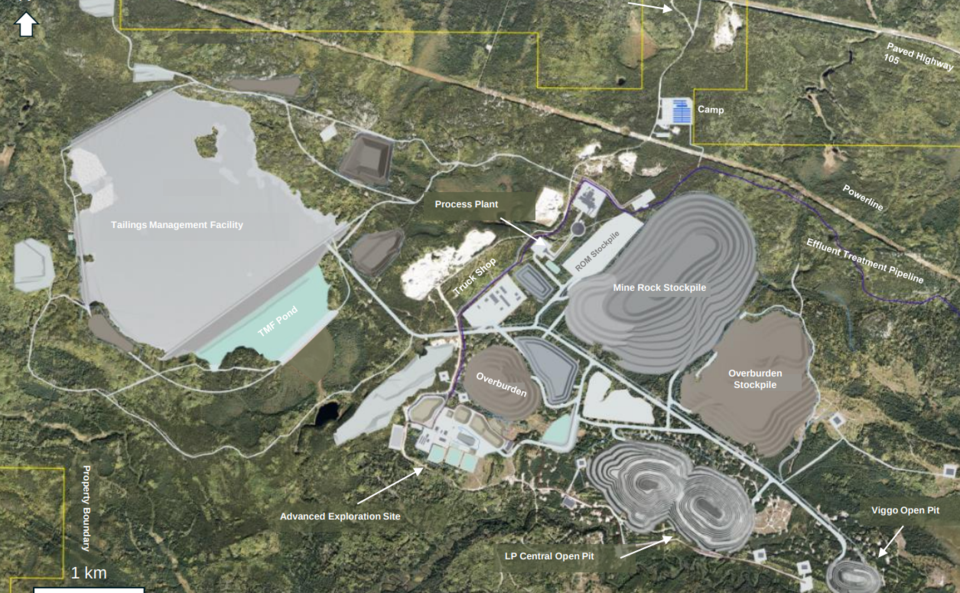Once the Great Bear project gets rocking and rolling in 2029, Kinross Gold projects its future Red Lake mine can be a 500,000-ounce-a-year producer.
The Toronto gold company released a preliminary economic study (PEA) on Sept. 10 of Great Bear showing a 12-year operating life that will churn out 5.3 million ounces of gold over that span.
In the PEA, Kinross paints a picture of mining high-grade material via open pit and underground methods, concurrently.
A PEA is an economic and technical study of what a mine could look like. The next stage of prefeasibility and feasibility studies will provide more detailed information on what a mine will look like.
Located 24 kilometres southeast of the town of Red Lake, Kinross acquired the project from junior miner Great Bear Resources in February 2022. Kinross wants to mine from three deposits dubbed LP, Hinge, and Limb.
The resource at Great Bear currently sits at a 6.6 million ounces in the measured, indicated and inferred categories, but the company expects that figure to grow substantially with more exploration work, especially at depth.
The company plans to dig an exploration decline next year to set up drill platforms underground to chase gold extensions deeper down.
During its peak mining period, Great Bear will employ almost 1,100 workers but will average 903 over its operating life.
The initial price tag to build the mine and the on-site processing mill is pegged at $1.2 billion. Kinross said in the news release that it’s confident it can “comfortably fund Great Bear, along with other planned capital spending.”
With its other mines in the U.S., Brazil, Mauritania, Chile and Canada, Kinross believes Great Bear will emerge as one of its cornerstone assets.
The plan is to mine from both an open pit and underground for the first eight years before transitioning entirely underground for the remaining four years, building up a stockpile of material for the mill in the later years of the operation.
But the ‘snapshot in time’ moniker usually attached to PEAs really applies to this project. Kinross is supremely confident Great Bear has the legs to last for a long time.
The high-grade drilling hits the company said it's seeing from deep down, as far down as 1,600 metres, will surely expand the gold base and extend the mine life.
In a statement, Kinross CEO Paul Rollinson said Great Bear can be a “world-class operating mine” with low costs and high margins.
"The project represents a strong combination of high-margin production and modest capital requirements, with the opportunity for significant resource growth in the future.”
Rollinson said the 12-year mine life is only the start.
“The ongoing drilling to depth has already shown multiple wide, high-grade intercepts beyond the current resource used in the PEA. This deep drilling from surface demonstrates the continuation of mineralization at depth and the upside potential for further resource and mine life additions in the future as we progress exploration from depth.”
On the permitting front, Kinross said it wants to continue exploration across “several areas” on its 11,852-hectare property, all subject to permit approvals from the Ontario government. The main mining project itself is undergoing a federal permitting review by the Impact Assessment Agency of Canada.
According to the project timelines, the final government permits for the mine should arrive in late 2027 with construction starting shortly afterwards in early 2028.
Production is slated for mid-2029, subject to government approval. Detailed engineering and procurement begins next year.
The on-surface site infrastructure will include a worker accommodations camp, administration office, truck shop and a “state-of-the-art” water treatment plant.
On the engagement side, Kinross said it has been consulting with area Indigenous communities, specifically Lac Seul and Wabauskang, on whose traditional land Great Bear is situated. The in-depth details on all things related to Great Bear are here.



